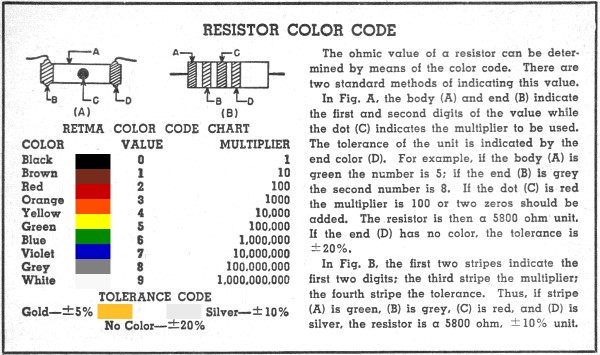Capacitor Color Code Chart
Capacitance is given in µµfd. Colors have the same values as on resistors, except as indicated in tables. Colors (A) and (B) are for first two digits; (e) is for multiplier. (D) is for tolerance, (E) and (F) give voltage rating in hundreds of volts; (E) is used only for ratings less than 1000 volts. (E) and (F) for first two digits of ratings 1000 volts or more. Values of colors for (E) and (F) are same as in resistance values. (G) is class or characteristic of capacitor. (H), (I), and (J) give temperature coefficient. (G), (H), (I), and (J) are not listed in the tables, since this information is seldom needed by the average home builder.

Capacitor Color Code Chart
Resistor Color Code Chart
The ohmic value of a resistor can be determined by means of the color code. There are two standard methods of indicating this value. In Fig. A. the body (A) and end (B) indicate the first and second digits of the value while the dot (C) indicates the multiplier to be used. The tolerance of the unit is indicated by the end color (D). For example. if the body (A) is green the number is 5; if the end (B) is grey the second number is 8. If the dot (C) is red the multiplier is 100 or two zeros should be added. The resistor is then a 5800 ohm unit. If the end (D) has no color. the tolerance is ±20%. In Fig. B. the first two stripes indicate the first two digits; the third stripe the multiplier: the fourth stripe the tolerance. Thus, if stripe (A) is green, (B) is grey, (e) is red, and (D) is silver. the resistor is a 5800 ohm, ± 10% unit.

Resistor Color Code Chart
